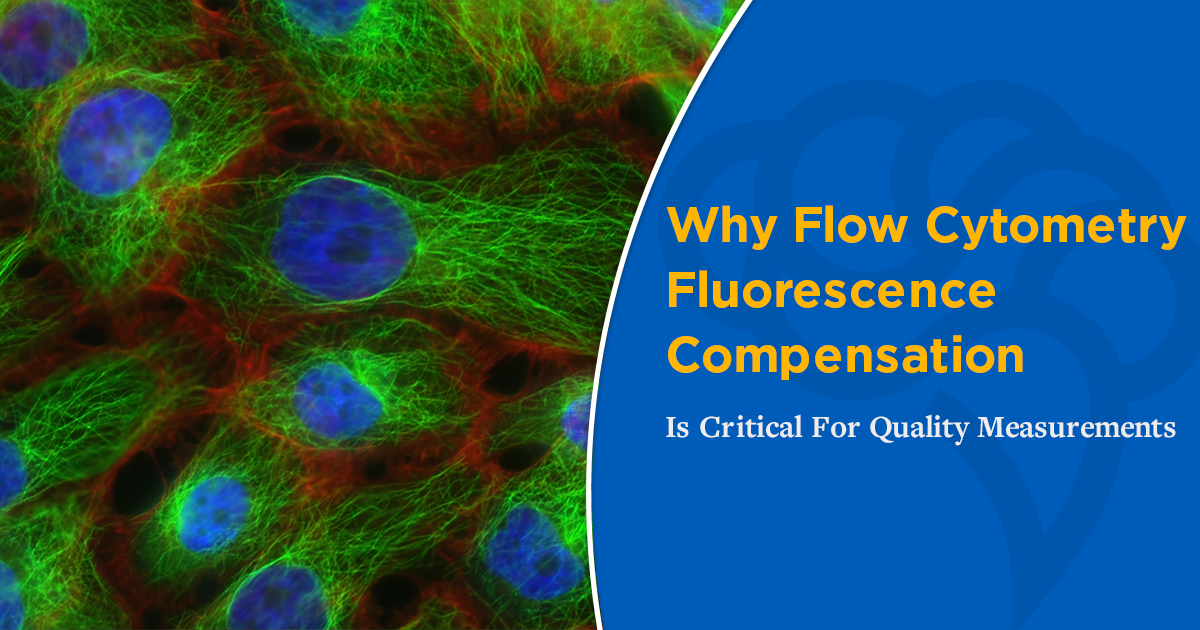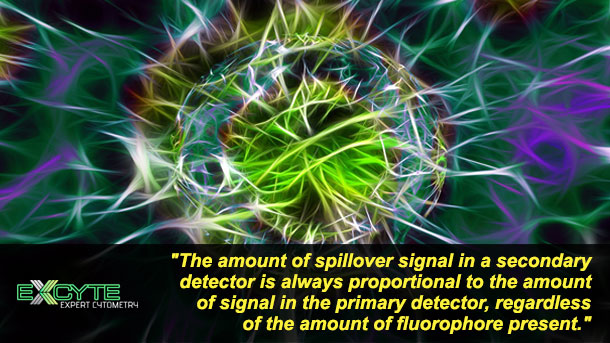Why Flow Cytometry Fluorescence Compensation Is Critical For Quality Measurements


Written by Tim Bushnell, PhD
Fluorescence compensation is one of the more difficult, understandably confusing, and misunderstood aspects of flow cytometry.
Compensation is almost always necessary when more than four or five colors are measured simultaneously. As such, understanding what compensation is, why it is necessary, and what to expect when using it, are critical for generating useful and high-quality data from flow cytometry experiments.
In order to understand compensation correctly, you need to understand the answers to 3 core questions related to compensation…

1. What is the nature of fluorophores?
The necessity of compensation arises from the nature of fluorophores, the fundamental and cherished tools of flow cytometry.
We often tend to associate a fluorophore with a particular color. For example, we often say that “FITC is ‘green’” and “APC is ‘red.’” While it is true that when FITC is excited it is most likely to emit photons in the “green” range (around 520 nm), it is also true that FITC will emit photons of other wavelengths of colors, from about 480-600 nm. However, the number of “non-green” photons that FITC emits gets lower and lower the farther the wavelength is from the emission maximum of FITC of ~520 nm.
The “spectral promiscuity” of fluorophores is a problem for flow cytometric measurements. A spectral plot, which describes the excitation and emission spectra of a fluorophore, is a powerful tool to understand why.
The plot shown below, reproduced from the BioLegend Spectra Analyzer, illustrates the emission spectra of two commonly used 405 nm excitable fluorophores: Brilliant Violet 510™ and Brilliant Violet 605™. Additionally, the spectral plot also illustrates the wavelength ranges (spectral bands) of bandpass filters that can be used to measure these fluorophores.

Notice how wide the curves are for both fluorophores and especially how wide the emission profile is for Brilliant Violet 510™.
This fluorophore, although mainly “green,” emits photons of all sorts of colors — from <450 nm all the way up to around 700 nm. That is quite a range! This wide span of emission wavelength quickly becomes a big problem as more and more colors are used.
The spectral detection range used in flow cytometry is about 370 nm up to about 800 nm, and there are only so many ways that this distance can be partitioned into spectral regions.
Because of this, spectral overlap, or the presence of one fluorophore in another’s detector, is inevitable in multicolor cytometry.
Specifically, in an experiment where two fluorophores are used, A and B, and two detectors designated to measure those fluorophores, DA and DB are used, A will be measured not only in DA but a portion of A’s fluorescence will also be measured in DB. Likewise, depending on the filter and the molecule, B may be measured in both DB and DA.
As illustrated in the spectral plot above, because of the wide emission profile of Brilliant Violet 510™, it will be detected in a bandpass filter about 85 nm away.

2. What is the spillover coefficient?
This reality of fluorophores would render data from multicolor experiments useless if something weren’t done to deal with it. That thing is compensation, which is a mathematical operation that accounts for and subtracts the spillover signal (i.e. the signal from other fluorophores) in every detector used in any flow cytometry experiment.
This process can be performed either manually or automatically, the automatic route being more preferable and accurate, especially as more and more colors are used.
While the comprehensive mathematical basis of compensation is beyond the scope of this article, taking the time to understand how it works from a high-level leads us one big step away from the “black box” model of interacting with a cytometer.
As always, the more transparent the box, the better the cytometry and the better the science.
The basic principle of compensation relies on one critical concept…
The amount of spillover signal in a secondary detector is always proportional to the amount of signal in the primary detector, regardless of the amount of fluorophore present.
In other words, in a two-color experiment utilizing fluorophore A and fluorophore B, if 20% of A’s emission spectrum is measured in B’s detector, we can always calculate the true signal of B in its detector, no matter how much of each dye is present, by co-opting the constant proportionality between A’s signal in B’s detector and A’s signal in A’s detector; the signal in from A in B’s detector is always 20% of A’s signal in its own detector.
To calculate this proportionality coefficient, properly called the spillover coefficient, we use single-color controls that contain only one fluorophore. By doing this, we can then measure the signal from this fluorophore, independently of any other fluorophore, in all detectors which facilitates calculation of the spillover coefficient.
Let’s look at the math to parse this out a bit. Stick with us here, even if math stirs up some trepidation.
The explanation below is from a report in a Current Protocols of Cytometry and it illustrates two-way compensation between two detectors, and assumes that we are using two fluorophores: fluorophore A and fluorophore B. While this is an atypically simple explanation, the principles described below carry through to the broader method compensation of any number of parameters.
We will use a few abbreviations, defined as follows:
AFA = signal from fluorophore A in its own detector (detector A)
AFB= signal from fluorophore A in B’s detector
BFB= signal from B in its own detector
BFA= signal from B in A’s detector
DA = total measured signal in A’s primary detector
DB = total measured signal in B’s primary detector
Therefore, the measured signals in each detector are:
DB = AFB+BFB
The spillover coefficients for A’s and B’s detectors, S, can be defined as follows:
BSA = BFA / BFB
In order to actually calculate the spillover coefficients, we need to measure signal from each fluorophore independently and thus need single color controls. The total signals, from a control containing only fluorophore A, in each detector is:
DB = AFB+BFB = AFB+ 0 = AFB
Therefore, for A’s single-stained control:
Similarly, for B’s single-stained control:
Once the proportionality constants are defined, the “real” fluorescence in any detector in a fully-stained sample can be easily calculated by rearranging equations. Easy!
In the fully-stained sample:
(BFB x BSA is obtained by rearranging the spillover coefficient for BSA)
DB = AFB+BFB = (AFA x ASB) + BFB
(AFA x ASB is obtained by rearranging the spillover coefficient for ASB)
All we need to do now is to do some crafty algebra to obtain the actual amount of A (AFA) in detector A and the actual amount of B (BFB) in detector B.

3. What is a compensation matrix?
When only two colors are used, the math is simple — it’s just algebra.
However, there is a way of calculating compensation for any number of parameters, which applies to more real-life cytometry experiments when many colors and detectors are used.
This method is an extension of the equations described above and uses linear algebra to generate a spillover coefficient matrix for all parameters being used to measure fluorescence in the experiment.
The math used in this case requires that the spillover coefficient matrix be inverted, which ends up as the compensation matrix.
The difference between the spillover coefficient versus the compensation matrix have been described in the same Current Protocols of Cytometry report:
Because the compensation matrix is more relevant to cytometry data — it tells us what to subtract from the detector in order to see the true fluorescence from its primary fluorophore — it is what is displayed in cytometry acquisition and analysis software.
You won’t ever have to perform these calculations yourself as, whether you are compensating manually or automatically, all of these calculations are performed by the computer. That being said, the cytometrist’s job is far from complete.
The basics of compensation as defined here provide foundational understanding of flow cytometry compensation. What it is, why it’s necessary, and what to expect make up the introduction to this series. Stay tuned for the next article on compensation for a deeper look into controls, the nuances of compensated data, and some mythbusting.
To learn more about why flow cytometry fluorescence compensation is critical for quality measurements and to get access to all of our advanced materials including 20 training videos, presentations, workbooks, and private group membership, get on the Flow Cytometry Mastery Class wait list.

ABOUT TIM BUSHNELL, PHD
Tim Bushnell holds a PhD in Biology from the Rensselaer Polytechnic Institute. He is a co-founder of—and didactic mind behind—ExCyte, the world’s leading flow cytometry training company, which organization boasts a veritable library of in-the-lab resources on sequencing, microscopy, and related topics in the life sciences.
More Written by Tim Bushnell, PhD













